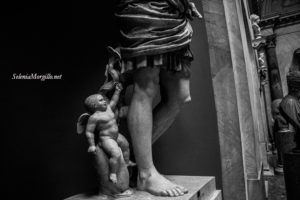Augustus of Prima Porta
(Italian Version below*)
The white marble statue was found in the villa of Livia Drusilia, wife of Augustus, in Prima Porta (along via Flaminia) in 1863.
It is also known as the Augustus loricato (from the lorica or the leather armor used by the legionaries).
Emperor Octavian Augustus is portrayed standing, in the moment preceding the adlocutio (solemn speech to the soldiers). This is underlined by the gesture of the raised right arm that seems to invoke silence before the emperor took the floor. Augustus wears the breastplate and the cloak around the hips (paludamentum).
The statue appears richly decorated; in the upper part, there is the personification of the Coelum under which the quadriga del Sol swirls.
In relief, in the central part the king of the Parthians gives back to a Roman general (for some it is Tiberius) the insignia torn from Crassus in 53 BC during the battle of Carre.
Leaning on the right calf of the emperor, the small figure of Eros, riding a dolphin.
The criticism dates the work, preserved in the Vatican Museums in the Braccio Nuovo, between 20 BC and the beginning of the first century AD.
Perhaps not everyone knows that… .. Careful studies have revealed traces of polychromy … .. When the sculpture was created it should not have appeared shiny white as we can admire it now, but colored.
Where to find it: Vatican Museums
How the “colored” sculpture looked: HERE
All rights reserved*
La statua in marmo bianco fu rinvenuta nella villa di Livia Drusilia, moglie di Augusto, a Prima Porta (lungo la via Flaminia) nel 1863.
E’ nota anche come l’Augusto loricato (dalla lorica ovvero la corazza in pelle utilizzata dai legionari).
L’Imperatore Ottaviano Augusto è ritratto in piedi, nel momento che precede l’adlocutio (solenne discorso ai soldati). Ciò è sottolineato dal gesto del braccio destro alzato che sembra invocare al silenzio, prima che l’imperatore prendesse parola. Augusto indossa la corazza ed il mantello intorno ai fianchi (paludamentum).
La scultura appare riccamente decorata; nella parte alta c’è la personificazione del Coelum sotto il quale volteggia la quadriga del Sol.
A rilievo nella parte centrale il re dei Parti restituisce a un generale romano (per alcuni è Tiberio) le insegne strappate a Crasso nel 53 a.C. durante la battaglia di Carre.
Appoggiato al polpaccio destro dell’imperatore, la piccola figura di Eros, che cavalca un delfino.
La critica data l’opera, conservata ai Musei Vaticani nel Braccio Nuovo, tra il 20 a.C. e gli inizi del I secolo d.C,.
Forse non tutti sanno che…..Attenti studi hanno rilevato tracce di policromia….. Quando fu creata la scultura non doveva apparire bianca splendente come la possiamo ammirare ora, ma colorata.
Info su dove trovarla: Musei Vaticani
Come appariva la scultura “colorata” : QUI
